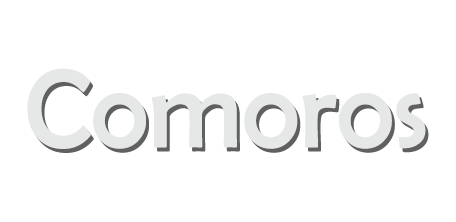
Officially known as the Union of Comoros, Comoros is a sovereign island nation, the name of which is derived from the Arabic word ‘qamar’ meaning ‘moon’. In addition to many smaller islands, Comoros has three major islands namely, Ngazidja, Mwali and Nzwani. The Mwali island of Comoros is one of the few places in the world where the Dhow (a kind of sail boat) is still built by some local Comorians. The volcanic islands of the Comorian archipelago have been called as ‘the perfumed islands’ for their fragrant plant life made up of the wonderful fragrance of vanilla, frangipani and ylang ylang. The islands attract a number of tourists especially the keen deep sea divers who are enthralled by the spectacular coral reefs. Home to an active volcano Mount Karthala, it is also known for its unspoilt white sand beaches, scenic beauty and numerous waterfalls and its friendly population. The local people present a fascinating insight to human migration from the early dawn of history and the peaceful co–existence of people of many ethnicities. Let us learn more about Comoros.
Nestled at the northern mouth of the Mozambique Channel, near Southern Africa, it is about two–thirds of the way between northern Madagascar and Northern Mozambique. Covering a total area of about 2,235 sq. km, it lies between the geographic coordinates 12°10’S latitude and 44°15’E longitude. Stretching a coastline of about 340 km, Comoros is slightly more than twelve times the size of Washington, DC and comparatively ranks 180th in the world.

Comoros enjoys a tropical marine climate with rainy season from November–May. Its terrain is made of volcanic islands while the interiors vary from steep mountains to low hills. The temperature reaches an average high of about 29°C–30°C in March during hot, rainy season and an average low of about 19°C in the cool, dry season. The lowest point of elevation is Indian Ocean at 0 m whereas the highest point is Karthala at 2,360 m. Fish is the only available natural resource. Comoros faces natural hazards like cyclones during rainy seasons from December–April and volcanic activity on Grande Comore. Soil degradation and erosion resulting from crop cultivation on the slopes without proper terracing of the soil and deforestation by cutting of trees are some of its environmental issues.

The flora of Comoros is characterized by a coastal zone of mangroves followed by coconut palms, mangoes and bananas. Mahogany trees and orchids are limited to the rugged slopes and on the high peaks, broom, heather and lichens grow. Aromatic plants such as frangipani (Plumeria), jasmine and lemongrass are found on the islands. The fauna on the islands includes land birds such as guinea fowl, egret and species of lemurs and fruit bats are peculiar to the island. The Comorian waters are home to coelacanth, a rare fish thought to be extinct. Besides these, the island is also home to civets, small lizards and giant land crabs.

Comorian society is traditionally made up of three traditionally social classes; the sultans, the farmers and the fishermen. Men work to support the household and meet the needs of the family. Women, on the other hand, bond together, form groups and influence village affairs and usually a cabinet post is reserved for them. In Islamic context, women work as Koran instructors. Despite polygamy, women enjoy a comfortable social status and position and are owners of the conjugal house enjoying a fair degree of financial freedom. The society is matrilineal in most of the aspects but a great wedding and lavish celebrations identifies the accomplishments of men. Circumcision of boys takes place in the age of four and pubescent girls are watched upon closely. Children are taught to respect and greet elders and women may not go out without a veil.

Islam is the dominant religion on the islands as about 98% of the Comorians are Sunni Muslims. However, a minority of the population are Roman Catholics. On the other hand, Shikomori (a blend of Swahili and Arabic), Arabic and French are the three official languages of Comoros Islands.

Rice is the staple food of the daily diet of the Comorians along with root vegetables, plantains, fresh and dried fish and coconut milk. Cultural influences from Africa, Indonesia, Madagascar, Arab world and Portugal have left their mark on the Comorian cuisine. As a result, Comorian cuisine involves many types of spices and exotic ingredients. For cooking rice, it is steamed with spices such as cloves, saffron, cinnamon and pomegranate juice. A typical Comorian meal always contains rice and meat seasoned with local ingredient vanilla, coriander, cardamom, cloves, cinnamon and nutmeg. Most of the other dishes include ingredients, such as bell peppers, maize, chillies, tomatoes, banana, pineapple, limes and oranges. Ceremonial dishes are prepared from beef and castrated goats and served with rice and curds along with huge cakes. A well known Comorian dish is ‘Akoho sy voanio’ made from chicken and coconut milk and served with rice. Another traditional dish is gruel or porridge made with dried fruit of sago palms.

Comoros is one of the poorest countries of the world. Growth of the economy is hampered as it is made up of three islands with inadequate transport links, increasing population and very few available natural resources. Its agricultural products include vanilla, cloves, ylang-ylang (perfume essence), copra, coconut, bananas and cassava. Industries which contribute to the development of the islands are fishing, tourism and perfume distillation. Comoros exports vanilla, ylang–ylang (perfume essence), cloves and copra to India, Singapore, France, Netherlands, Turkey, US, Saudi Arabia and Germany whereas it imports rice and other foodstuffs, consumer goods, petroleum products, cement and transport equipment from France, Pakistan, China, UAE, India and Kenya.



